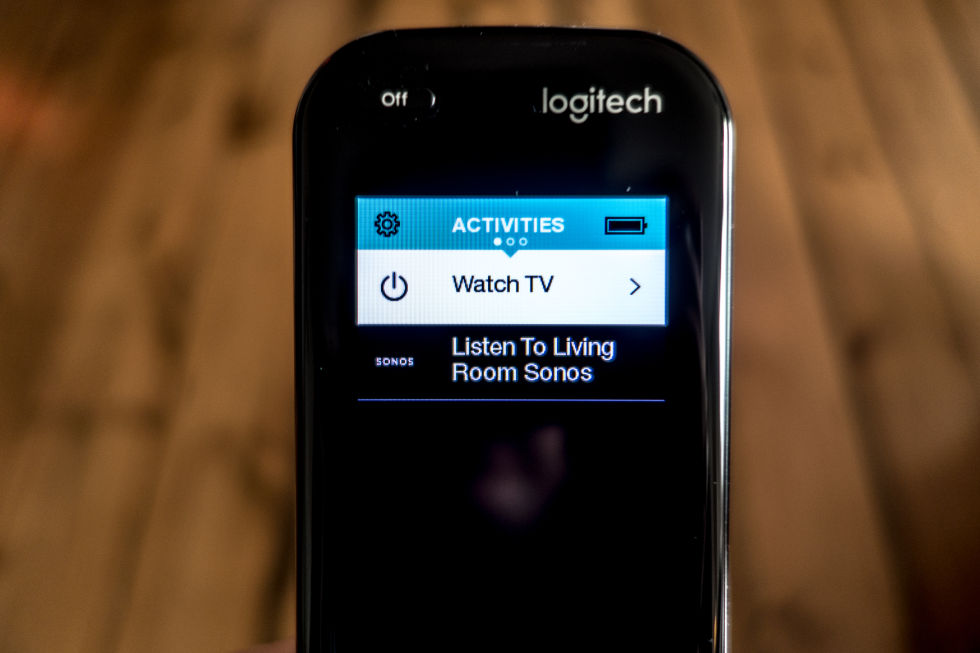
Logitech's Harmony Elite is the closest I've got to achieving the smart home dream. You know, the one where you enter the house, all the lights flick on, and the entertainment system boots up to your favourite channel while the heating system asks if the temperature is cosy enough for you—that sort of thing. The problem has always been standards: the Internet of Things (IoT) has lots of them, but few of them play nicely together.
The £279 ($350) Harmony Elite bridges the gap with a fancy touchscreen remote, charging dock, smartphone app, and a wireless hub, letting you control most infrared, Bluetooth, and IoT devices from either the included remote, or a smartphone app. The hub—which you can purchase separately for £99 ($99)—is the where the magic happens. Logitech sells the remote separately for £199 in the UK, as well as range of cheaper models, but none feature the Wi-Fi/Bluetooth IoT wizardry that makes the Elite bundle so appealing.
The hub is a small hockey puck-sized blob of glossy black plastic that, while a complete magnet for dust and fingerprints, is largely inoffensive. Aside from the power jack on the back, there are two inputs for the separate IR blasters included in the box. Whether you need these or not will depend on your setup. The hub has its own crazy-powerful IR blaster inside that reflects the IR signal off other surfaces, so if if all your devices are located in the same place it works perfectly on its own.
My setup, however, is a little more complicated. Some devices like the Shield Android TV and PlayStation 4 live inside a cupboard, while my Sky+ HD satellite TV box lives underneath it, and my AV amplifier lives on top. Obviously, when the cupboard door is shut, IR signals can't get in or out. But by running the two extenders out from the main unit inside the cupboard, I'm still able to control those devices without the need for any line-of-sight communication from the hub or the remote.
Universal remotes are still a pain in the arse
If only plugging everything in was the hard part. Logitech has done its best to make setting up the Elite as easy as possible, but unfortunately there's still something of a learning curve to getting everything working together, particularly when using IoT devices. The good news is that you don't have to use Logitech's ropey desktop app on Windows or Mac to get things set up. Instead, everything except upgrading the remote's firmware—which it only asked me to do once after I'd set everything else up—is done through the iOS or Android app.



The initial setup guides you through adding your devices, with the app splitting them into Entertainment, Wi-Fi, or Computer categories. Entertainment covers pretty much any device that uses IR or Bluetooth to communicate, with the Elite's stupidly large database of IR codes making it a snap to search for a device. If you do run into trouble with a particular device—as I did with my Sky+ HD box—you can manually add the IR code by pointing the device's remote at the hub and pushing a few buttons.
What was particularly impressive was just how quickly the Elite found devices on my network to communicate with. My LG TV, for example, is hard-wired via Ethernet. Instead of using IR, the Elite controls the TV over the Ethernet connection, removing any wireless worries. It also found the Sonos in my bedroom automatically over the network, as well as my PlayStation 4.
There are some limitations, though. With the Sonos you can only do things like play/pause, skip through tracks, and adjust the volume; music browsing is limited to things you've saved to your Sonos favourites from within the dedicated Sonos app. Thanks to Sony not allowing third-party devices to toggle power on the PS4, you still have to manually power it on before your can use it with the Elite.
IoT devices are also more complicated to set up. For Philips Hue, I had to manually push the sync button on top of the Hue hub, and it took a few attempts before the Elite recognised the Hue system and connected to it. The selection of IoT devices the Elite works with is also limited to a few big names at the moment, which includes the likes of Google's Nest, Samsung's Smart Things, and Lifx and Philips Hue Smart Bulbs. The Hive heating system I use—which is far more prevalent in the UK than Nest—doesn't currently work.
Oh, and if you were thinking that the Elite replaced all those IoT hubs you have knocking about, think again. The individual hubs still all need to be plugged in in order for the Elite to control everything. That's not the Elite's fault as such, but it does mean that you've got to add yet another hub with its own power supply to the pile.
However, my biggest pet peeve with the Elite has to be the "Connecting to Harmony servers" message that greets you every time you want to add or tweak a device setting. It takes a good 10-15 seconds before the app connects. If you have a lot of devices to add, or tweaks to make, this gets very annoying very quickly.
reader comments
18